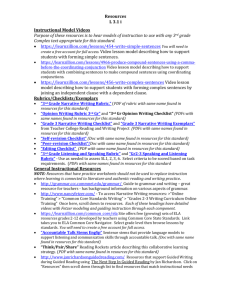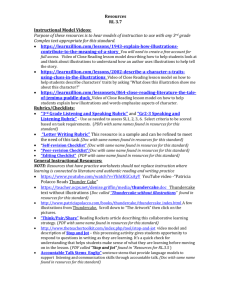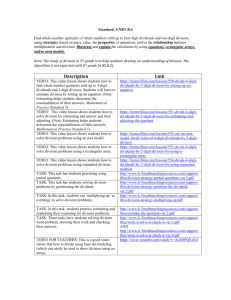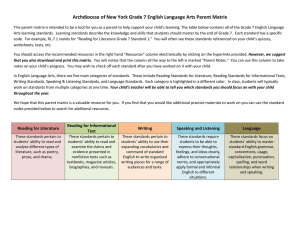Instructional Model Videos
advertisement
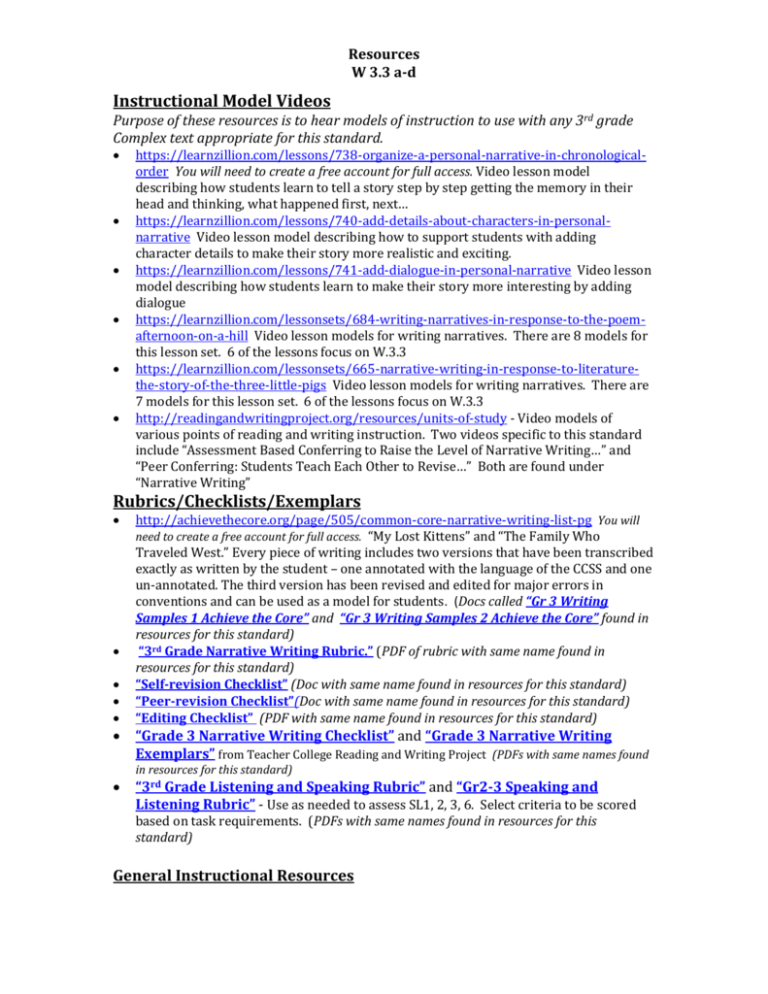
Resources W 3.3 a-d Instructional Model Videos Purpose of these resources is to hear models of instruction to use with any 3 rd grade Complex text appropriate for this standard. https://learnzillion.com/lessons/738-organize-a-personal-narrative-in-chronologicalorder You will need to create a free account for full access. Video lesson model describing how students learn to tell a story step by step getting the memory in their head and thinking, what happened first, next… https://learnzillion.com/lessons/740-add-details-about-characters-in-personalnarrative Video lesson model describing how to support students with adding character details to make their story more realistic and exciting. https://learnzillion.com/lessons/741-add-dialogue-in-personal-narrative Video lesson model describing how students learn to make their story more interesting by adding dialogue https://learnzillion.com/lessonsets/684-writing-narratives-in-response-to-the-poemafternoon-on-a-hill Video lesson models for writing narratives. There are 8 models for this lesson set. 6 of the lessons focus on W.3.3 https://learnzillion.com/lessonsets/665-narrative-writing-in-response-to-literaturethe-story-of-the-three-little-pigs Video lesson models for writing narratives. There are 7 models for this lesson set. 6 of the lessons focus on W.3.3 http://readingandwritingproject.org/resources/units-of-study - Video models of various points of reading and writing instruction. Two videos specific to this standard include “Assessment Based Conferring to Raise the Level of Narrative Writing…” and “Peer Conferring: Students Teach Each Other to Revise…” Both are found under “Narrative Writing” Rubrics/Checklists/Exemplars http://achievethecore.org/page/505/common-core-narrative-writing-list-pg You will need to create a free account for full access. “My Lost Kittens” and “The Family Who Traveled West.” Every piece of writing includes two versions that have been transcribed exactly as written by the student – one annotated with the language of the CCSS and one un-annotated. The third version has been revised and edited for major errors in conventions and can be used as a model for students. (Docs called “Gr 3 Writing Samples 1 Achieve the Core” and “Gr 3 Writing Samples 2 Achieve the Core” found in resources for this standard) “3rd Grade Narrative Writing Rubric.” (PDF of rubric with same name found in resources for this standard) “Self-revision Checklist” (Doc with same name found in resources for this standard) “Peer-revision Checklist”(Doc with same name found in resources for this standard) “Editing Checklist” (PDF with same name found in resources for this standard) “Grade 3 Narrative Writing Checklist” and “Grade 3 Narrative Writing Exemplars” from Teacher College Reading and Writing Project (PDFs with same names found in resources for this standard) “3rd Grade Listening and Speaking Rubric” and “Gr2-3 Speaking and Listening Rubric” - Use as needed to assess SL1, 2, 3, 6. Select criteria to be scored based on task requirements. (PDFs with same names found in resources for this standard) General Instructional Resources Resources W 3.3 a-d NOTE: Resources that have practice worksheets should not replace instruction where learning is connected to literature and authentic reading and writing practice Examples of Mentor Texts to Prompt Thinking for Narrative Writing Hey World, Here I Am! (Jean Little) The Old Woman Who Named Things and When I Was Young in the Mountains (Cynthia Rylant) Wilfrid Gordon McDonald Partridge (Mem Fox) Peter’s Chair ( Ezra Jack Keats) Owl Moon (Jane Yolen) Chicken Sunday (Patricia Polacco) Bigmama’s (Donald Crews) A Chair For My Mother (Vera B. Williams) (Doc called “Suggested Mentor Texts for Narrative Writing” with more titles found in resources for this standard) “Writing With Mentor Texts Webinar” Background research on using Mentor Texts to support writing. (PDF with same name found in resources for this standard) “Using Mentor Texts to Empower Student Authors” (PDF with this name found in resources for this standard) https://www.choiceliteracy.com/articles-detail-view.php?id=994 Choice Literacy Interview with Ralph Fletcher about using Mentor Texts http://www.ascd.org/publications/educationalleadership/apr14/vol71/num07/Making-the-Most-of-Mentor-Texts.aspx Educational Leadership Article: Making the Most of Mentor Texts “Think/Pair/Share” Reading Rockets article describing this collaborative learning strategy. (PDF with same name found in resources for this standard) http://www.nancyfetzer.com/ - To access Narrative Writing resources: >“Online Training” > “Common Core Standards Writing” > “Grades 2-3 Writing Curriculum Online Training” Once here, scroll down to find resources for: The Writing Process, Narrative Writing, Narrative Writing Tools Each of these headings has detailed videos with Fetzer modeling and guiding instruction through each component. http://flippingenglish.weebly.com/uploads/6/2/7/5/6275953/creating_believable_ch aracters.pdf - questions to consider when creating believable characters. (PDF called “Creating Believable Characters” found in resources for this standard) “Everyday Editing” – Go to pages 143 - 156 “What’s Up? Teaching Dialogue” – Indepth instructional guidelines for modeling/teaching dialogue. (PDF with same name found in resources for this standard) https://learnzillion.com/common_core/ela Site offers free (growing) sets of ELA resources grades 2-12 developed by teachers using CCSS. Link takes you to ELA Common Core Navigator. Select grade level then browse lessons by standards. “Accountable Talk Stems EngSp” These are sentence stems that provide language models to support students with their listening and communication skills through accountable talk. (Doc with same name found in resources for this standard) http://www.janrichardsonguidedreading.com/ Resources that support Guided Writing during Guided Reading using The Next Step In Guided Reading by Jan Richardson. Click on “Resources” then scroll down through extensive list to find resources that match instructional needs.
